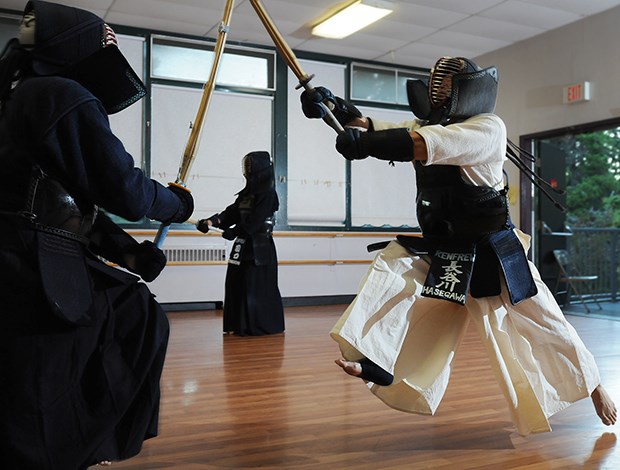The sweat was already dripping down Sensei Yoshiaki Taguchi’s face and neck as he took to the front of his class at Renfrew Kendo Dojo on a hot Thursday night at Hastings Community Centre.
Instructor Taguchi,67, has been practising this Japanese martial art of sword fighting for 32 years. He has achieved the seventh Dan, or level of skill in kendo, and he plans to test for the eighth and final Dan within a year.
“After level four or five it gets really interesting,” he said. “Level eight is spiritual.” Taguchi explained that judges are looking for near perfection in speed, form and delivery at the top levels.
As is tradition, Taguchi is not paid for the six hours a week he devotes to teaching a small group of students, a mix of men, women and children, each wearing the traditional navy blue or white Japanese kendo robe, called a keikogi and long pants called hakamas.
The students assembled silently in front of Taguchi, bowing in unison and then remained silent as he led them in a meditation prior to practice.
“It is quite a serious and dangerous sport. This time allows us to get rid of all the stuff from the outside world and focus on what we are about to do,” said kendo student Russ Gray who has practised on and off in Canada and Japan since 1978.
Students then paired off, bowed to each other and then, with bamboo swords called shinais raised, rushed at their opponents and shouted as they hit particular areas of the body.
“I enjoy the physical part of the sport as well as the mental discipline that it helps to instill,” said Gray whose active seven-year-old daughter Moeka joined her dad in the class. He researched other clubs and was most impressed with Taguchi, he said. “He is a great and patient teacher.”
Kendo is truly a family affair for the Taguchis. Taguchi’s wife Eriko,61, is also a kendo master after being inspired when her son Daisaku and husband started practising the sport. She was “lonely and bored at home,” she said, and would head down to the dojo (the training center) and put daughter Maya on her equipment bag, where the baby was happy resting until the family finished practice.
“They are Japanese immigrants that came to this country when they were in their early 20s and when there was very little Asian influence in Vancouver,” said Maya, herself a three-time North American Women’s Kendo Champion, by email. “They have carried many of their Japanese traditions and ideals with them and have passed it along to my brother and I.
“Kendo is one of the few Japanese martial arts that retains a strong sense of culture, tradition and respect.”
The second hour of the lesson was for adults only, and participants donned helmets complete with metal face cages and leather collars. The energy of the class switched into high gear. For observers, the cacophony of crashing swords and voices was overwhelming. They shouted a common refrain, “Men!” the Japanese word for mask, as they hit an opponent’s face.
Make sure the sound is turned on:
After class, Gray was philosophical about the sport as he wiped sweat from his brow. “Having kendo as a part of your life steels your mind and spirit to other challenges you may encounter. Not an art of violence […] but an art of the mind and spirit.”
According to Eduardo Cigliutti, spokesman for the Canadian Kendo Federation, Kendo has 800 official members in Canada and 184 of those living in B.C., which is second in number only to Ontario.
To learn more, visit Renfrew Kendo online.
Twitter.com/thuncher



